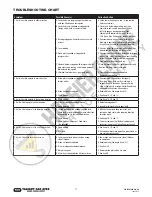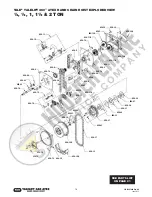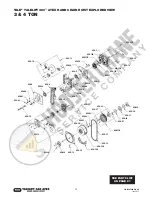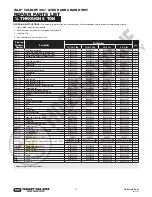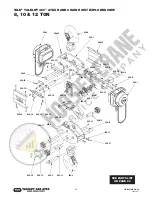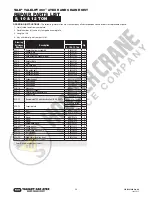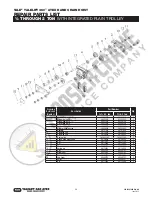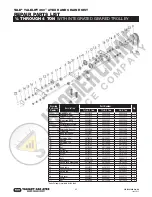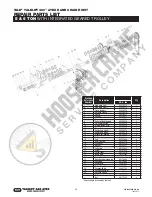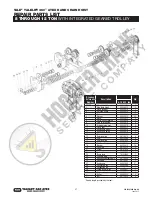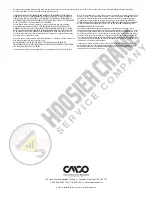
17
P/N 10001646 Rev. AA
June 2015
TROUBLESHOOTING CHART
Symptom
Possible Cause(s)
Corrective Action
1. Hoist is hard to operate in either direction.
A. Load chain worn long to gauge, thus binding
between liftwheel and chain guide.
A. Check chain, (See pages 9 and 10) and replace
if worn excessively.
B. Load chain rusty, corroded or clogged with
foreign matter such as cement or mud.
B. Clean chain by tumble polishing or using a
non-acid or non-caustic type solvent. Check
chain for gouges, damaged or bent links.
Lubricate with Lubriplate
®
Bar and Chain Oil
10-R (Fiske Bros. Refining Co.) or equal lubricant.
C. Bushings clogged with matter such as cement
or dust.
C. Disassemble and clean liftwheel bushings and
bushings in gear cover and side plate (gear side).
Any parts worn excessively should be replaced.
D. Lever binding.
D. Clean by removing any foreign matter which may
be between the lever and the brake cover.
E. Brake parts corroded or clogged with
foreign matter.
E. Disassemble brake and clean thoroughly (by wiping
with a cloth - not by washing in a solvent). Replace
ratchet assembly if too gummy, worn or scored.
Keep brake surfaces clean and dry.
F. Liftwheel pockets clogged with foreign matter or
worn excessively causing chain to bind between
liftwheel and chain guide.
F. Clean out pockets and use if not worn excessively.
Replace liftwheel if pockets are worn.
G. Liftwheel twisted or bent - gear teeth bent.
G. Excessive overload had been applied.
Replace damaged parts.
2. Hoist is hard to operate in down direction.
A. Brake parts corroded or clogged with
foreign matter.
A. Disassemble brake and clean thoroughly.
(By wiping with a cloth- not by washing in a
solvent). Replace brake disc if gummy, visibly
worn or coated with a foreign matter. Keep brake
disc and brake surfaces clean and dry.
B. Brake not properly adjusted.
B. Readjust brake (See pages 9 and 10).
C. Chain binding.
C. See Items 1A, 1B and 1C.
3. Hoist is hard to operate in the hoisting direction.
A. Chain binding.
A. See Items 1A, 1B and 1C.
4. Hoist will not operate in either direction.
A. Driver or stops on handwheel broken.
A. Replace damaged part.
B. Gears jammed
B. Inspect for foreign matter in gear teeth.
5. Hoist will not operate in the lowering direction
A. Locked brake due to a suddenly applied load,
shock load, or load removed by means other than
by operating unit in the lowering direction.
A. With hoist under load keep chain taut, pull
sharply on hand chain in the lowering direction
to loosen brake.
B. Chain binding
B. See Items 1A, 1B and 1C.
C. Lower hook all the way out. Load chain
fully extended.
C. Chain taut between the liftwheel and loose end
connector. Operate unit in hoisting direction only.
6. Hoist will not operate in the hoisting direction
A. Chain binding
A. See Items 1A, 1B and 1C.
B. Overload
B. If handwheel slips while operating, reduce load or
use correct capacity hoist.
7. Hoist will not hold load in suspension.
A. Lower hook or load side of chain on wrong
side of liftwheel.
A. Lower hook must be on same side of liftwheel
as upper hook
B. Brake not properly adjusted.
B. Readjust brake (See pages 9 and 10t).
C. Driver or stops on handwheel broken.
C. See Item 4A.
D. Worn brake parts.
D. Replace brake parts which are worn.
E. Oily, dirty or corroded brake friction surfaces.
E. See Item 2A.















